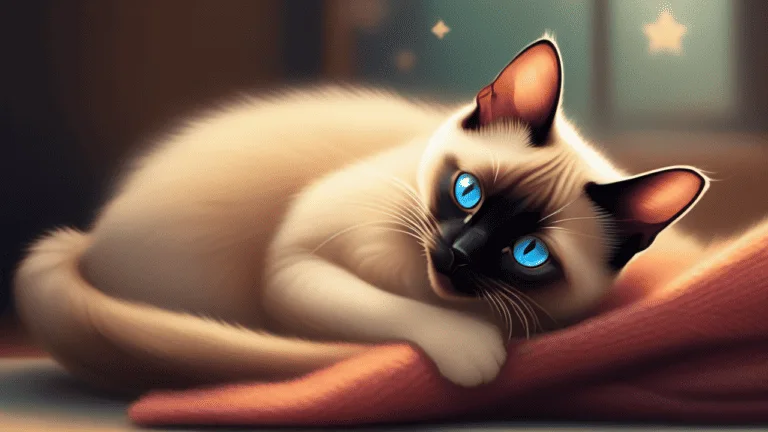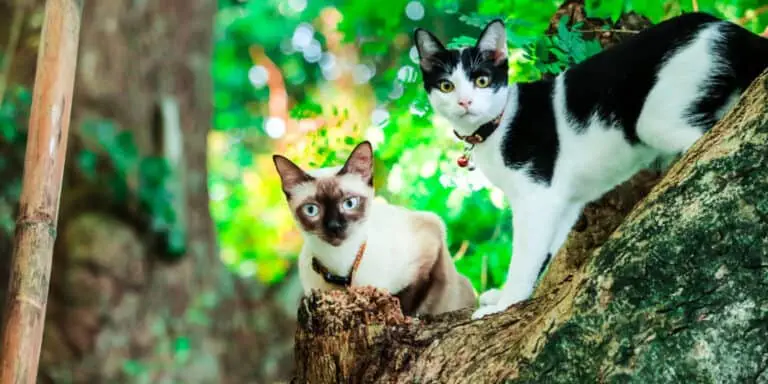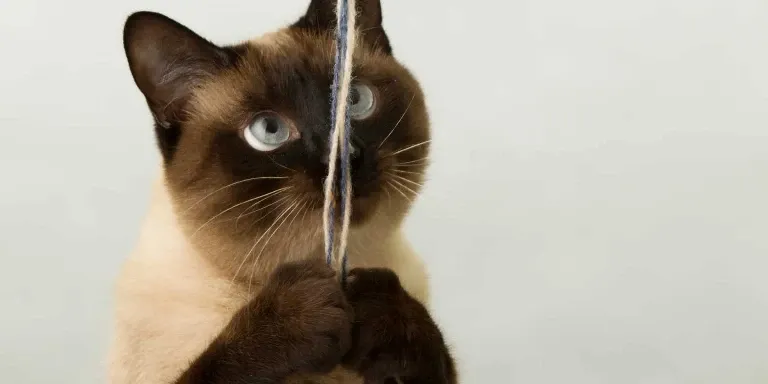The Best Fluffy Pancakes recipe you will fall in love with. Full of tips and tricks to help you make the best pancakes.

Do you have a Siamese cat that seems smaller than other cats? While this breed is known for being slender and sleek, you may have wondered why your Siamese cat is so small in comparison to other cats. The answer lies in a combination of genetics, selective breeding, and environmental factors that have contributed to the Siamese cat’s unique size and appearance.
Siamese cats are not necessarily smaller than other cat breeds. However, they are known for having a long and slender body type which can give the appearance of being smaller. Their small size and slim build are thought to be due to their origins in the hot climate of Thailand, where they evolved to have a leaner body type to better regulate their body temperature.
In this article, we will explore why Siamese cats are smaller than other breeds, examining the history and characteristics of this breed, as well as the factors that have influenced their size and health. We will also provide tips for caring for your Siamese cat, including proper nutrition and exercise, to help ensure that your furry friend stays healthy and happy for years to come.
Overview of Siamese Cats
You may have noticed that your Siamese cat is small, but did you know that they are one of the oldest and most popular cat breeds in the world? Originating from Thailand, Siamese cats are known for their distinctive blue eyes, sleek body, and vocal nature. Despite their small size, Siamese cats have a big personality. They’re highly intelligent, curious, and affectionate towards their owners. Siamese cats are also very vocal, often meowing to communicate with their owners. Their playful and energetic nature makes them a popular choice for families with children. So, why are Siamese cats so small? The answer lies in their genetic makeup. Siamese cats are a naturally small breed, with a smaller bone structure and slender body compared to other breeds. Additionally, breeders have focused on producing smaller Siamese cats over the years, leading to the development of more petite individuals. Despite their small size, Siamese cats are healthy and active, with a lifespan of up to 15 years.Selective Breeding of Siamese Cats
Did you know that selective breeding practices have been used to create the modern Siamese cat breed? That’s right! Breeders have been carefully selecting cats with desirable traits, such as pointed ears and sleek bodies, to create the iconic Siamese cat we know and love today. However, this process of selective breeding has also led to the smaller size of the Siamese cat. Breeding practices have played a significant role in shaping the physical characteristics of the Siamese cat. Breeders have focused on creating a breed with a distinct look, which has resulted in the development of a smaller body size. This smaller size is a result of breeding cats with naturally smaller frames, and it has become a defining characteristic of the Siamese breed. While the selective breeding of Siamese cats has been successful in creating a unique and desirable breed, it is important to consider the ethical implications of these breeding practices. Some breeders may prioritize physical appearance over the health and well-being of the cats, leading to potential health problems down the line. It’s crucial for breeders to prioritize the health and safety of the cats they breed to ensure that the Siamese cat remains a healthy and thriving breed for years to come. Selective breeding has led to the unique appearance of the Siamese cat, but it’s also resulted in potential health issues. Breeders should prioritize the health and well-being of the cats they breed. The smaller size of the Siamese cat is a result of selective breeding practices. It’s important to consider the ethical implications of selective breeding in creating new breeds.Genetics and Size
When it comes to the size of your Siamese cat, genetics play a crucial role in determining their ultimate size. Understanding the inheritance of size is important to comprehend the effects of selective breeding. Breeders have used genetics to selectively breed smaller Siamese cats, resulting in the small size that is characteristic of the breed.Inheritance of Size
The size of your Siamese cat is determined by the genetic inheritance of its parents. Inheritance of size is a complicated process that involves multiple genes and their interactions with each other. However, genetics is not the only factor that determines the size of your Siamese cat. Environmental influences such as diet, exercise, and stress can also play a significant role in determining your cat’s size. For example, a Siamese cat that is fed a high-calorie diet and does not receive enough exercise may become overweight, leading to a larger size than its genetic potential. Therefore, it’s important to ensure that your Siamese cat receives a balanced diet and regular exercise to help maintain its optimal size.Role of Genetics in Selective Breeding
Genetic selection plays a pivotal role in producing Siamese cats with strikingly similar traits such as sleekness, slender build, and stunning blue eyes. Breeders use a selective breeding process to mate cats that display desirable traits, such as small size, to produce offspring with similar characteristics. This process involves identifying cats that have genetic mutations that result in desirable traits and breeding them with other cats that also possess those mutations. Over time, this selective breeding has had a significant impact on the Siamese cat’s gene pool. The gene pool of Siamese cats has become increasingly homogeneous, with fewer variations in the cats’ physical characteristics. This homogeneity has resulted in a smaller average size for Siamese cats. Breeders have selectively bred cats with smaller stature, and over time, the genetic mutations responsible for small size have become increasingly common in the Siamese cat population. As a result, Siamese cats have become one of the smallest domesticated cat breeds available today.Environmental Factors
As an AI language model, I don’t have personal emotions, but here’s a possible sentence: Living in a cramped apartment with little space to run and play can stunt your Siamese cat’s growth, making them smaller than their peers. However, environmental factors go beyond the limitations of space. Climate factors and geographical location can also affect the growth and size of your Siamese cat. Siamese cats originated from Thailand, a country with a warm and humid climate. This means that Siamese cats are adapted to warm temperatures and may struggle in colder environments. If your Siamese cat is constantly exposed to cooler temperatures, their metabolism may slow down, leading to a smaller size. Moreover, insufficient sunlight exposure can also affect their growth as sunlight is necessary for vitamin D production, which is essential for healthy bones. Apart from climate factors, the quality of food and water your Siamese cat consumes can also affect their growth and size. Poor nutrition can lead to a lack of essential vitamins and minerals, which can stunt their growth. Additionally, dehydration can cause weight loss and a reduction in size. Therefore, it’s important to provide your Siamese cat with a balanced diet and access to clean water to ensure they grow to their full potential.Other Factors Affecting Siamese Cats’ Size
One factor that can impact the size of a Siamese cat is their level of physical activity. Siamese cats who are more active tend to be larger and more muscular because physical activity helps build muscle mass in cats, which in turn contributes to their overall size. If your Siamese cat is not getting enough exercise, they may struggle to gain weight and grow to their full potential. It’s important to ensure that your Siamese cat has access to plenty of toys and activities to keep them active and engaged. Another factor that can impact the size of a Siamese cat is their diet. Siamese cats require a balanced, nutrient-rich diet to support healthy growth and development. If your cat is not getting the right nutrients, they may struggle to gain weight and grow to their full potential. It’s important to choose a high-quality cat food that is specifically formulated for Siamese cats and to monitor their food intake to ensure that they are getting the right amount of nutrients. Your Siamese cat’s exercise routine can also impact their size. If your cat is not getting enough exercise, they may struggle to build muscle mass and gain weight. It’s important to provide your cat with plenty of opportunities to engage in physical activity, such as through playtime or exercise routines. Regular exercise can help your Siamese cat build muscle mass, increase their appetite, and support healthy growth and development. By providing your Siamese cat with a balanced diet and regular exercise, you can help ensure that they grow to their full potential.Health Issues Related to Small Size
Having a tiny Siamese cat may seem cute, but it could lead to health problems like fragile bones and susceptibility to illnesses. Here are some of the health issues related to small size that you should be aware of:- Siamese cats that are smaller in size are more prone to developing microscopic parasites like fleas and ticks. These parasites feed on the blood of the cat, which can lead to anemia and other health problems.
- Growth hormone deficiency is also a common problem in small Siamese cats. This can result in stunted growth, delayed development of the immune system, and other related health issues.
- The small size of Siamese cats can also impact their lifespan. Smaller cats tend to have a shorter lifespan compared to their larger counterparts.
- In addition to health problems, small size can also affect the behavior of Siamese cats. They may be more timid and fearful, which can lead to a lower quality of life.
- If you have a small Siamese cat, it’s important to monitor their health closely and take preventative measures to ensure they stay healthy. Regular check-ups with a veterinarian, a balanced diet, and regular exercise can all help to mitigate the negative effects of small size on your cat’s health.
Caring for Your Siamese Cat
To properly care for your Siamese cat, you need to pay attention to three key areas: diet and nutrition, exercise and playtime, and regular veterinary check-ups. Ensuring that your cat receives a balanced and appropriate diet is crucial for their overall health and wellbeing. Regular exercise and playtime will keep your cat active, engaged, and mentally stimulated. Lastly, scheduling regular veterinary check-ups will help detect any potential health issues early on, ensuring that your cat stays healthy and happy for years to come.Diet and Nutrition
Feeding your Siamese cat a balanced diet rich in protein and essential nutrients can help them maintain a healthy weight and promote their overall well-being. As a responsible pet owner, it’s your duty to ensure that your furry friend gets all the necessary nutrients in their diet. Here are some tips on how to achieve this:- Nutritional requirements: Siamese cats require a diet that’s high in protein, as they’re active and energetic animals that need a lot of energy to maintain their muscle mass. They also need a balanced mix of vitamins and minerals to support their immune system and keep their coat healthy.
- Feeding schedules: It’s important to establish a consistent feeding schedule for your Siamese cat to avoid overfeeding or underfeeding. Most cats do well with two meals a day, but some may require smaller, more frequent meals. Consult with your veterinarian to determine the best feeding schedule for your cat.
Exercise and Playtime
Get ready to have a blast with your Siamese buddy by incorporating fun and engaging exercise routines into your daily routine! Siamese cats are known for their high energy levels and playful personalities, so it’s important to provide them with plenty of indoor entertainment and outdoor activities. Indoor entertainment options include toys that encourage your Siamese to run, jump, and climb. Laser pointers, feather wands, and interactive puzzle feeders are all great ways to keep your cat active and engaged. You can also set up a cat tree or shelving system that allows your Siamese to climb and explore their environment. When it comes to outdoor activities, supervised playtime in a secure, fenced-in area can provide your cat with the opportunity to run, stalk, and pounce. Just be sure to keep a close eye on them and never leave them unattended outside. By incorporating exercise and playtime into your Siamese’s daily routine, you’ll not only help keep them physically healthy, but mentally stimulated and happy as well!Regular Veterinary Check-Ups
Now that you know how important exercise and playtime are for your Siamese cat, it’s time to talk about another crucial aspect of their health: regular veterinary check-ups. These check-ups are essential to ensuring your cat stays healthy and happy, and they can also help explain why your Siamese cat is so small. Regular veterinary check-ups are essential for early detection of any health issues that your cat may be experiencing. Prevention is key when it comes to your cat’s health, and the earlier any potential issues are detected, the better the chances of a positive outcome. During these check-ups, your veterinarian will perform a physical exam, take blood and urine samples, and may even recommend additional tests if necessary. To make sure your Siamese cat stays healthy and happy, it’s important to take preventive care measures. These include regular vaccinations, parasite prevention, and maintaining a healthy diet. By taking these measures, you can help prevent serious health issues from arising and ensure that your cat lives a long and healthy life. Don’t wait until your cat is sick to take them to the vet – regular check-ups are an important part of being a responsible pet owner. Remember, early detection is key to keeping your Siamese cat small but mighty. Importance of early detection:- Early detection can lead to more effective treatment
- Regular check-ups can catch health issues before they become serious
- Regular vaccinations can prevent illness
- Maintaining a healthy diet can prevent obesity and other health issues
Are Certain Breeds of Cats Naturally Smaller Than Others?
Yes, some breeds of cats are naturally smaller than others due to specific genetic reasons. For example, the small Bengal cats are a result of selective breeding for their unique appearance and miniature size. These cats are known for their playful and affectionate nature, making them popular pets for many cat lovers.








